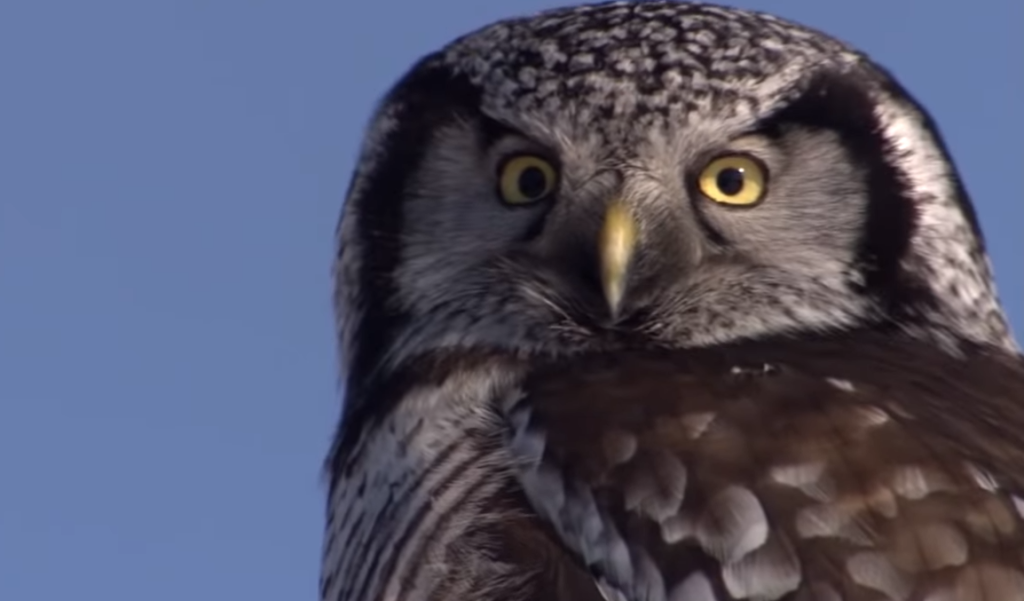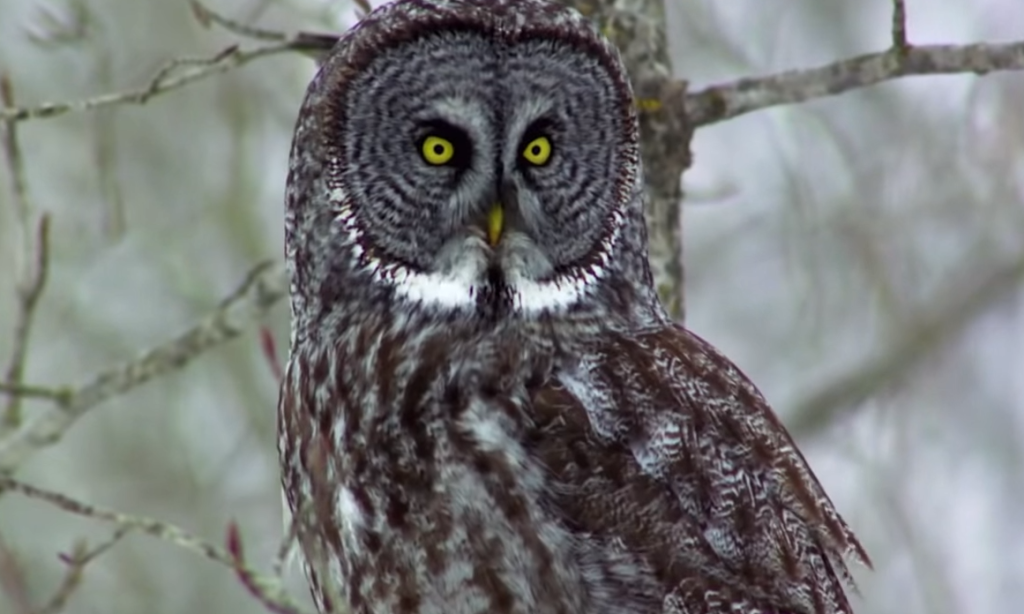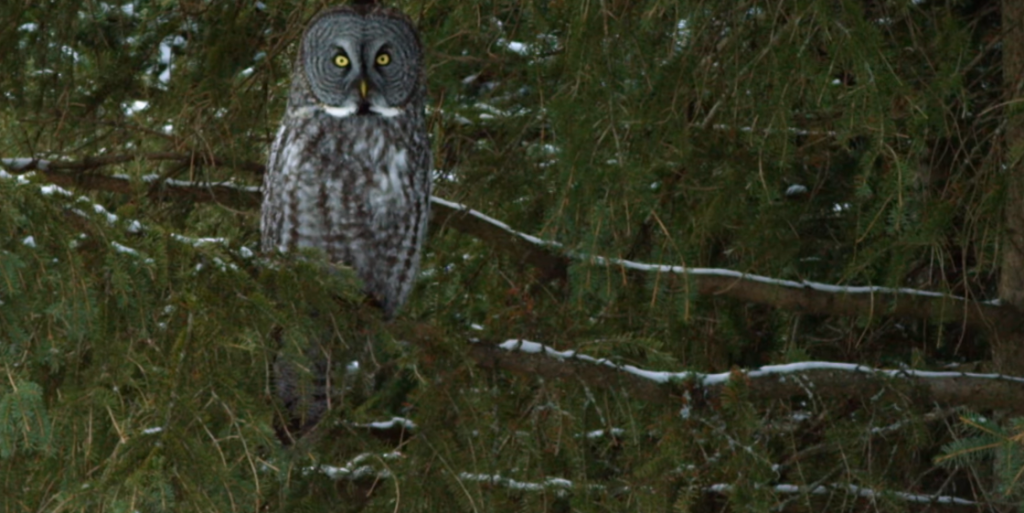Why do owls have flat faces? Owls are fascinating creatures with a unique physical feature that sets them apart from other birds – their flat faces.
The flat face of an owl is also known as a facial disc. The facial disc is made up of soft feathers that are arranged in a specific way.
The flattened facial structure of owls plays a crucial role in enhancing their exceptional hunting abilities, to help them hear better, to help them see better. allowing them to locate and capture prey with astonishing accuracy and precision.
In this article, we will delve into the reasons behind why owls have flat faces and explore the incredible advantages it provides for these enigmatic birds of prey.
Why Do Owls Have Flat Faces?
Owls have flat faces for two main reasons:
- To help them hear better. The flat face of an owl acts like a sound dish, collecting sound waves and directing them towards the owl’s ears. This helps the owl to pinpoint the location of its prey, even if it is hidden in the darkness.
- To help them see better. The flat face of an owl also helps to focus light onto the owl’s eyes. This is important for owls, as they hunt in low-light conditions.
The flat face of an owl is also known as a facial disc. The facial disc is made up of soft feathers that are arranged in a specific way.
The feathers on the front of the facial disc are shorter than the feathers on the back, which helps to focus sound waves.
The feathers on the sides of the facial disc are also angled slightly forward, which helps to direct sound waves towards the owl’s ears.
This allows them to see their prey in great detail, even in the dark. Owls also have very sensitive hearing, which helps them to track the movements of their prey.
The combination of a flat face, large eyes, and sensitive hearing makes owls very effective hunters. They are able to locate and capture their prey even in the darkest of nights.
Anatomy of an Owl’s Face
An owl’s face is a remarkable adaptation that allows it to be highly efficient in hunting and surviving in its environment. Here are some key features of an owl’s face:
- Flat Facial Disc: The most distinctive feature of an owl’s face is its flat facial disc, which acts as a parabolic dish to capture and funnel sound towards the ears. This unique structure helps owls locate prey accurately even in complete darkness.
- Large Eyes: Owls have large eyes compared to their skull size, giving them excellent vision, especially at night. Their eyes are fixed in position within bony eye sockets, limiting their ability to move their eyes. However, they can rotate their heads up to 270 degrees to compensate for this limitation.
- Forward-facing Eyes: Unlike many other birds with side-placed eyes, owls have forward-facing eyes on the front of their face. This binocular vision allows them to perceive depth and judge distances accurately when hunting.
- Facial Feathers: Owls possess specialized feathers around their face that serve multiple purposes. These feathers help direct sound into the ear openings by creating a “sound shadow” effect, enhancing the accuracy of sound localization.
- Ear Asymmetry: One interesting aspect of an owl’s facial anatomy is the asymmetrical positioning of its ears; one ear is higher than the other on each side of the head. This arrangement enables precise triangulation when locating sounds emitted by potential prey.
Why Do Some Owls Have Flat Faces?
Not all owls have flat faces. In fact, some owls have very round faces. The shape of an owl’s face depends on its species and its hunting habits.

Owls with flat faces, such as barn owls and great horned owls, are typically nocturnal hunters. They use their flat faces to help them hear and see their prey in the dark.
The flat face acts like a sound dish, collecting sound waves and directing them towards the owl’s ears. This helps the owl to pinpoint the location of its prey, even if it is hidden in the darkness.
What Is the Facial Structure of An Owl?
The facial structure of an owl is unique and adapted to their nocturnal hunting habits. The most notable feature of an owl’s face is the facial disc.
The facial disc is a concave area of feathers that surrounds the owl’s eyes. The feathers on the facial disc are arranged in a specific way that helps to collect sound waves and direct them towards the owl’s ears.

In addition to the facial disc, owls also have large, forward-facing eyes. This gives owls excellent binocular vision, which allows them to see their prey in great detail, even in low-light conditions.
Here are some other features of an owl’s facial structure:
- Ears: Owls have asymmetrical ears, which means that one ear is slightly higher than the other. This helps the owl to pinpoint the location of sound sources.
- Beak: Owls have a sharp beak that is used to tear apart their prey.
- Talons: Owls have long, sharp talons that are used to grasp and kill their prey.
Why Do Owls Have Large Forward-Facing Eyes?
Owls have large forward-facing eyes for two main reasons:
- To provide binocular vision
- To collect more light
Do Owls Have Large Eyes and A Flat Face?
Yes, owls have large eyes and a flat face. The large eyes help owls to see in low-light conditions, and the flat face helps owls to hear their prey.

The large eyes of an owl are fixed in their sockets, so the owl can only turn its head to look around. This is why owls have such a flexible neck, so they can turn their heads almost 360 degrees
Do All Owls Have Heart-Shaped Faces?
No, not all owls have heart-shaped faces. Only owls in the Tytonidae family have heart-shaped faces.
This family includes barn owls, which are the most common owls in the world. Other owls in the Tytonidae family include African wood owls, Malay scops owls, and African scops owls.
Is an Owl only Forward Facing Eyes Predator?
Yes, owls are the only birds with forward-facing eyes. This gives them excellent binocular vision, which allows them to see their prey in great detail, even in low-light conditions.
Forward-facing eyes also allow owls to judge distances accurately, which is important for hunting. Other birds with forward-facing eyes include raptors such as hawks and eagles.
What Does an Owl’s Face Resemble?
An owl’s face has been described as resembling a satellite dish or a heart. The shape of the owl’s face is an adaptation that helps them to hear their prey.

The feathers on the facial disc are arranged in a specific way that helps to collect sound waves and direct them towards the owl’s ears. This allows the owl to pinpoint the location of its prey, even if it is hidden in the darkness.
How Do Facial Discs in Owls Function?
The facial disc of an owl is a concave collection of feathers that surrounds the owl’s eyes. The feathers on the facial disc are arranged in a specific way that helps to collect sound waves and direct them towards the owl’s ears.
This allows the owl to pinpoint the location of its prey, even if it is hidden in the darkness. The facial disc works like a sound dish.
The owl’s ears are also asymmetrical, which means that one ear is slightly higher than the other. This helps the owl to pinpoint the location of sound sources.
Do Owls of All Species Have the Same Facial Characteristics?
No, owls of all species do not have the same facial characteristics. The facial characteristics of an owl vary depending on the species of owl.
The Purpose of Flat Faces in Owls
Owls have flat faces, also known as facial discs, which serve several important purposes. Here’s a look at why owls have evolved this unique feature:
- Enhanced Hearing: Owls are renowned for their exceptional hearing abilities, and their flat faces play a crucial role in enhancing this sense. The concave shape of the facial disc helps to direct sound waves towards the owl’s ears, allowing them to pinpoint even the faintest sounds with remarkable accuracy.
- Improved Sound Localization: By having a flat face with asymmetrical ear openings positioned on either side, owls can detect minute differences in sound arrival time and intensity between their ears. This enables them to precisely locate the source of a sound, whether it be prey rustling in leaves or potential threats approaching.
- Silent Flight: Another advantage of owls’ facial discs is that they contribute to their silent flight capability. The soft feathers around the edges of the disc help to muffle any noise generated by flapping wings, making owls exceptionally stealthy hunters.
- Focusing Sound Waves: The arrangement of feathers within an owl’s facial disc aids in focusing incoming sound waves onto its ear openings. These specialized feathers act like satellite dishes that channel and concentrate sound towards the owl’s ears, further improving its ability to hear distant or quiet noises.
- Camouflage Enhancement: In addition to their functional benefits for hearing and hunting, owls’ flattened faces also provide camouflage advantages by breaking up their outlines against tree bark or other surfaces when perched during daylight hours.
Advantages of Flat Faces for Hunting
Flat faces provide several advantages for owls when it comes to hunting. Here are some key benefits:
- Enhanced Depth Perception: The flat facial disc of an owl acts like a satellite dish, directing sound waves towards their ears. This arrangement allows them to accurately locate prey even in complete darkness, giving them exceptional depth perception.
- Improved Hearing: Owls have asymmetrical ear placements on their face, which helps them pinpoint the exact location of potential prey through differences in volume and timing between their ears. Their flat faces help capture and funnel sounds effectively towards these specialized ears.
- Silent Flight: A crucial advantage for owls is their ability to fly silently, enabling them to sneak up on prey without being detected. The unique feather structure around the face and head creates a soft fringe that muffles any sound generated by wing movement.
- Concealment: Owls’ flattened facial discs can also play a role in camouflage during daylight hours when they roost among branches or rest against tree trunks. By compressing their feathers close to the body and tilting their heads downward, they can blend seamlessly into the environment.
- Aid in Focusing Sound Waves: The shape of an owl’s flat face helps concentrate incoming sound waves onto its sensitive ear openings by deflecting unnecessary noise from other directions.
- Effective Sound Localization: Due to the positioning of an owl’s eyes on its flattened face—forward-facing rather than lateral—they benefit from binocular vision and excellent depth perception while hunting at night or low-light conditions.
Conclusion! Why Do Owls Have Flat Faces?
The flat faces of owls serve several important purposes. Firstly, their facial structure allows for enhanced sound localization.
The flat shape of their face acts as a natural sound dish, directing sounds towards their ears and enabling them to accurately pinpoint the source of prey or potential threats.
This unique adaptation gives owls a significant advantage in hunting and surviving in their environment. The flattened face helps owls to maintain stealth during flight.
By reducing air resistance and minimizing turbulence around their head, owls are able to fly silently through the night sky without giving away their presence.
FAQs
Why Do Owls Have Flat Faces?
Owls have flat faces primarily due to their unique adaptations for hunting and capturing prey. The distinct facial structure plays a crucial role in their ability to hunt efficiently and effectively.
How Does the Flat Face of An Owl Help in Hunting?
The flat face of an owl helps in hunting by enhancing their hearing and vision capabilities. The facial disc, a circular arrangement of feathers around the owl’s face, acts as a sound collector, directing sound waves towards their ears.
This allows owls to detect even the slightest movement or rustle made by their prey.
Does the Flat Face Affect Their Hearing Abilities?
No, in fact, the flat face of owls enhances their hearing abilities. The facial disc funnels sound waves into their ears, amplifying and focusing the sounds.
This specialized adaptation allows owls to have exceptional hearing and locate prey with incredible accuracy, even in low-light conditions.
Can Owls See Better Because of Their Flat Faces?
While the flat face of an owl primarily aids in their hearing abilities, it does have secondary benefits for their vision.
The wide, forward-facing eyes of owls, positioned on their flat face, provide them with excellent depth perception and a wide field of vision, enabling them to accurately judge distances and spot prey from a distance.
Are There Any Other Advantages to The Flat Face of Owls?
Besides aiding in hunting, the flat face of owls also helps them camouflage and stay hidden during the day.
The arrangement of feathers on their facial disc can create a pattern that resembles tree bark or enhance their overall camouflage, allowing them to blend seamlessly into their surroundings.
Are All Owls’ Faces Flat?
Not all owls have a completely flat face, but most owl species possess some degree of facial flattening. The exact shape and extent of flatness can differ among different owl species, depending on their hunting habits and specific adaptations.




